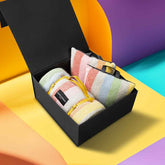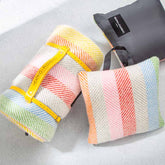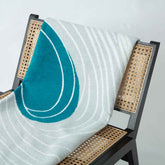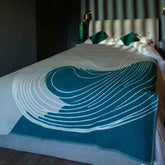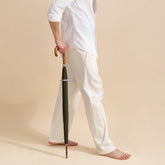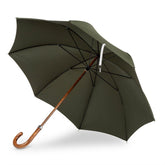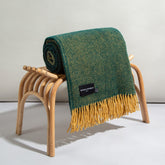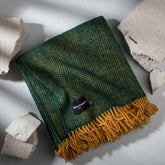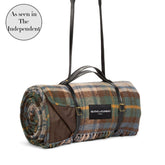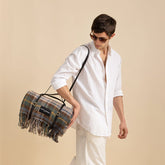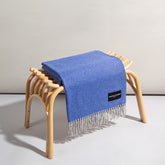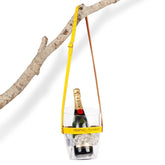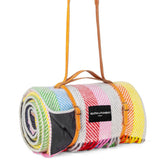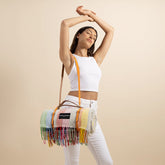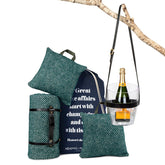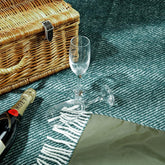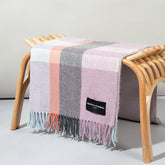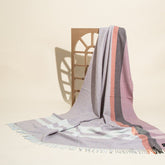Wool vs. Fleece, Cotton & Synthetics: How to Choose the Best Throw for Your Home
Shopping for a new throw blanket but not sure whether to choose wool, fleece, cotton, or synthetic materials? Each fabric has its own strengths and drawbacks—some are warmer, some softer, some easier to care for. Picking the right one depends on your climate, lifestyle, and budget.
This guide breaks down the differences so you can find the best throw for your home, whether you want cosy winter warmth, a lightweight summer layer, or a stylish decorative piece.
Key Takeaways
-
Wool is the warmest and most durable option, ideal for cold climates and long-term use.
-
Fleece is lightweight, very soft, and affordable, but less breathable than natural fibres.
-
Cotton is breathable and easy to wash, making it perfect for warmer months.
-
Synthetic fibres (like acrylic and polyester blends) are low-cost and easy-care but less eco-friendly.
-
Your ideal throw depends on climate, allergies, maintenance preferences, and whether you prioritise style, comfort, or longevity.
Throw or Blanket?
A throw is a smaller, decorative blanket designed for comfort and style. Unlike a bed blanket, it’s usually draped over sofas, armchairs, or beds for easy reach. The material you choose affects not only how the throw feels but also its warmth, breathability, durability, and maintenance needs.

Wool Throws
Characteristics: Natural fibre from sheep, prized for its insulating and moisture-wicking qualities.
Advantages:
-
Exceptional warmth, even when damp
-
Long-lasting and hard-wearing
-
Naturally odour-resistant and flame-retardant
-
Renewable and biodegradable
Disadvantages:
-
Higher cost than other materials
-
May feel itchy for sensitive skin
-
Requires more careful cleaning (dry cleaning or gentle hand washing)
Best for: Cold climates, eco-conscious buyers, anyone looking for an investment piece that will last for decades.
Fleece Throws
Characteristics: Synthetic material, typically made from polyester, known for its softness and light weight.
Advantages:
-
Budget-friendly and widely available
-
Very soft and cosy
-
Quick-drying and easy to wash
-
Retains warmth well
Disadvantages:
-
Less breathable than natural fibres
-
Prone to static build-up
-
Can pill with frequent washing
Best for: Everyday casual use, children’s rooms, people with wool allergies.

Cotton Throws
Characteristics: Natural plant-based fibre, soft and breathable.
Advantages:
-
Hypoallergenic and gentle on skin
-
Breathable for year-round comfort
-
Machine washable and low-maintenance
-
Available in a wide variety of styles and weaves
Disadvantages:
-
Less insulating in cold conditions
-
Can shrink if washed or dried at high heat
Best for: Warm climates, layering in spring/summer, and households needing easy-care textiles.
Synthetic Fibre Throws (Other than Fleece)
Materials: Acrylic, polyester blends, and microfibre.
Advantages:
-
Affordable and widely available
-
Large range of colours and patterns
-
Low-maintenance and machine-washable
Disadvantages:
-
Less breathable and less warm than wool
-
Prone to pilling
-
Not biodegradable, less eco-friendly
Best for: Decorative purposes, budget-conscious shoppers, and low-maintenance households.
Side-by-Side Comparison Table
|
Feature |
Wool |
Fleece |
Cotton |
Synthetic (Other) |
|
Warmth |
★★★★★ |
★★★★☆ |
★★☆☆☆ |
★★★☆☆ |
|
Breathability |
★★★★☆ |
★★☆☆☆ |
★★★★★ |
★★☆☆☆ |
|
Durability |
★★★★★ |
★★★☆☆ |
★★★★☆ |
★★★☆☆ |
|
Maintenance |
Hand wash/Dry clean |
Machine wash |
Machine wash |
Machine wash |
|
Eco-friendliness |
★★★★★ |
★★☆☆☆ |
★★★★★ |
★☆☆☆☆ |
|
Price Range |
High |
Low-Mid |
Mid |
Low |

How to Choose the Best Throw for Your Home
-
Climate: Choose wool for cold winters, cotton for warm climates, fleece for moderate year-round use.
-
Allergies: Opt for hypoallergenic cotton or synthetic if sensitive to wool.
-
Maintenance: If you prefer low-maintenance textiles, pick fleece, cotton, or synthetic.
-
Budget: Synthetics and fleece are the most affordable; wool is a higher-priced long-term investment.
-
Purpose: Decorative throws can be synthetic or cotton; functional, warmth-focused throws are best in wool or fleece.
Care Tips by Material
-
Wool: Dry clean or hand wash with wool-safe detergent, air dry flat, store with moth deterrents.
-
Fleece: Machine wash cold, avoid high heat to prevent melting fibres.
-
Cotton: Machine wash cool or warm, avoid high-heat drying to prevent shrinkage.
-
Synthetic: Machine wash, tumble dry low, avoid excessive heat to prevent fibre damage.
FAQ – Choosing the Best Throw Material
Is wool warmer than fleece?
Yes. Wool naturally insulates better than fleece, retaining warmth even when damp. However, fleece is still cosy and can feel warmer to the touch because of its plush surface.
Which throw fabric is best for summer?
Cotton is the best choice for summer due to its breathability and light weight.
Are synthetic throws bad for the environment?
Synthetic fibres are made from non-renewable resources and are not biodegradable. If sustainability is a priority, opt for wool or organic cotton.
How long does a wool throw last?
With proper care, a high-quality wool throw can last decades, often becoming softer over time.
Which throw is easiest to care for?
Fleece and synthetic throws are the easiest to maintain—they can usually be machine washed and dried without special handling.
























